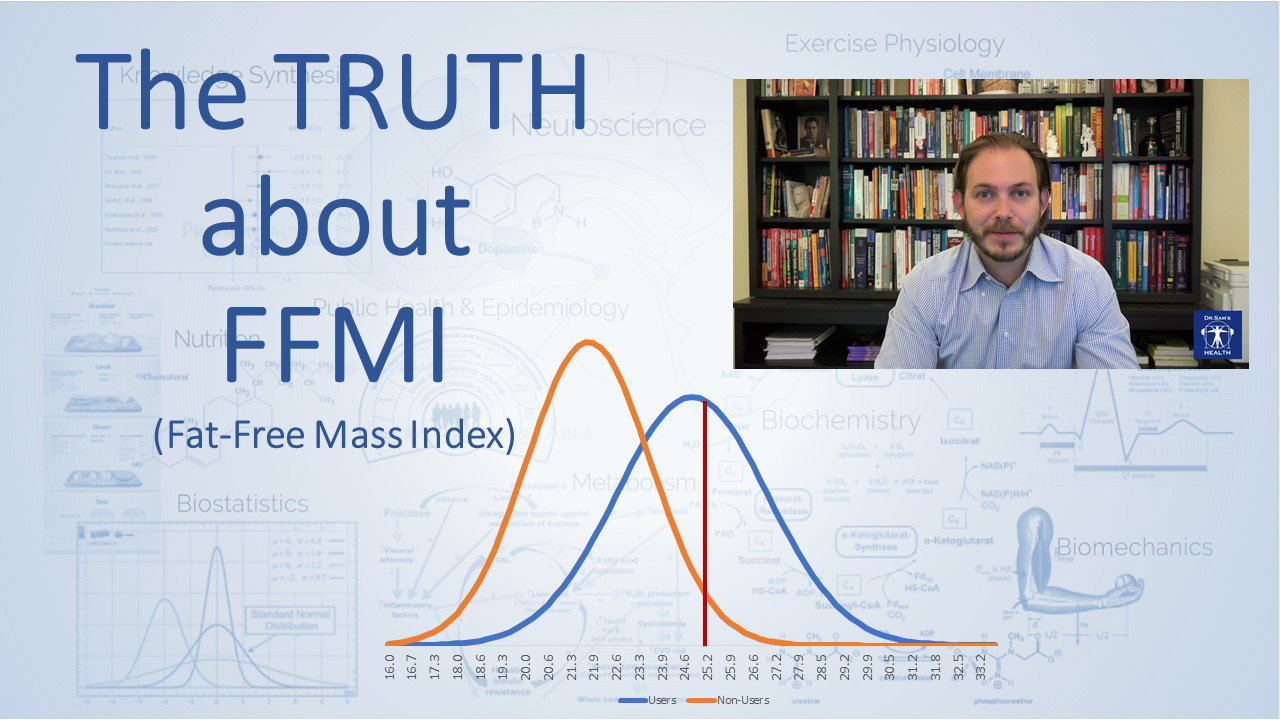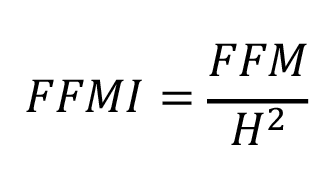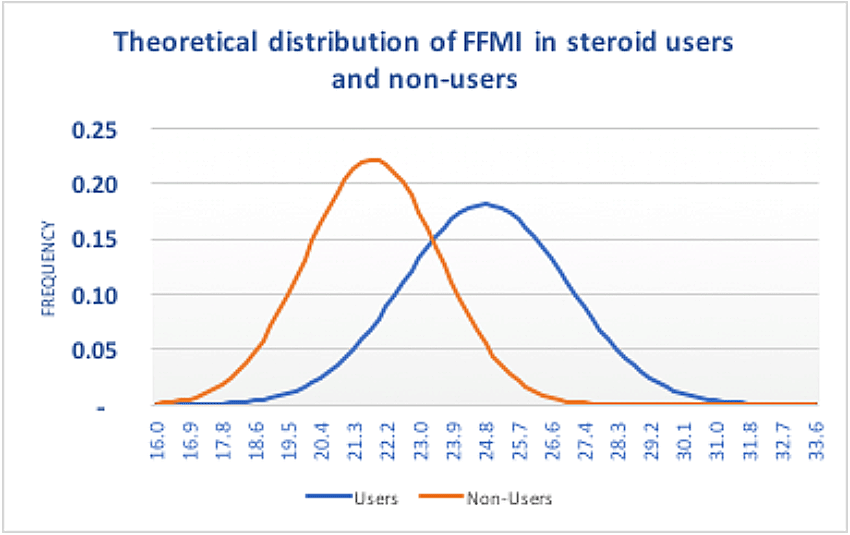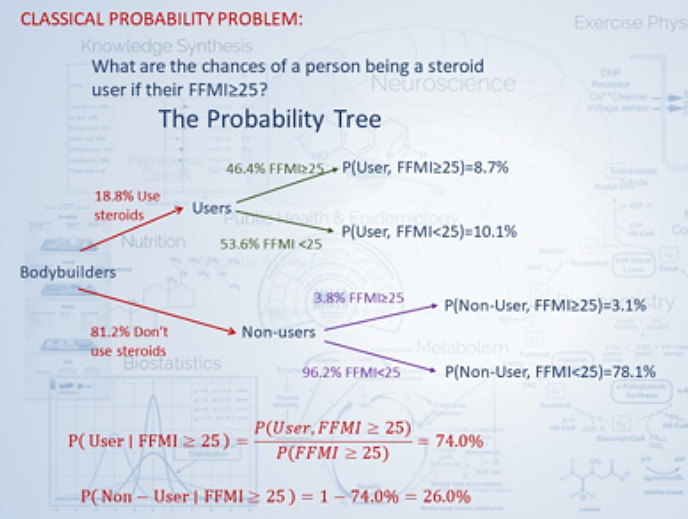
Recently, I’ve come across quite a few blogs and YouTube videos dedicated to the Fat-Free Mass Index (FFMI). Apparently, there was an interesting study done in 1983 where researchers compared the FFMI of steroid users to non-users and showed that there is a significant difference between them1. It looks like these days a lot of fitness gurus are trying to use the FFMI as an indicator of steroid use. They say specifically that if someone’s FFMI is higher than 25 it’s a sure tell that they are steroid users. Let’s look at the data and see if this approach has merit.
What is FFMI?
Let’s start with describing what FFMI is and how to calculate it. The FFMI, as the name implies, is the index designed to reflect the level of muscular development. It is calculated in the same way as the body mass index (BMI), but instead of using total body weight, we are using the fat-free (lean body) mass. So, the formula looks like that:

, where FFM is fat-free mass in kilograms and H is height in meters.
This index indeed appears to be useful for estimates of muscular development as it allows for elimination of the BMI variability related to fat mass.
What were the original study findings?
The researchers have conducted a study with 157 athletes – those who admittedly were steroid users (n=83) and those who weren’t (n=74) and calculated their FFMIs. They found that the average FFMI among users was 24.8±2.2 and among non-users – 21.8±1.8. The difference was substantial and statistically significant, which allowed the authors to suggest using FFMI as a screening instrument for steroid use. The recommended cut-off score is 25 i.e. if someone’s FFMI is 25 or higher it’s very likely that they are steroid users (according to the authors). This approach makes sense, but I’d like to point out that the information provided in the study doesn’t really allow for estimating the actual chance of a person being a steroid user and I’ll explain why, but before that I would like to finish our conversation about the study findings and the things we can do with these data.
What can we learn from this study?
The findings of the study gave us enough information to understand the distribution of FFMI scores in steroid users and non-users, which is a very valuable piece of information – having these data allows for building theoretical distributions of the FFMI in populations of steroid users and non-users based on the empirical findings (perfect or not). I have plotted the theoretical distributions of FFMI for users and non-users (see Fig.1)

The reason for these data and distributions being so important is that now we can place individuals somewhere on these distributions and confidently say what percentile they are in, or, in other words, how likely it is that a certain athlete to have a specific FFMI value if they are a natural athlete or a steroid user (please note the direction of the probability estimates).
For example, if someone’s FFMI is exactly 25 it means that they are in the 96th percentile among non-users, or in the top 4% of them in terms of their muscularity, which is obviously a great achievement, but in the end of the day, being in the top 4-5% on any performance test is a typical benchmark for many highly competitive professions. At the same time having an FFMI of 25 places a person somewhere in the middle of the distribution of steroid users, so their results are close to average. Now if we switch the direction of probability estimations, does it mean that the person is likely to be a steroid user? The answer – we cannot be certain. Moreover, the article of Kourie et al., 1983 doesn’t really provide us with the information required for estimating the probability of a person being a steroid user, which is a classical probability problem and brings us to the last section of this blog.
What is the chance that the person with FFMI of 25 is a steroid user?
In order to calculate a conditional probability (and that’s what it is), we need to know the prevalence of steroid use among athletes. I did a quick literature search and found out that there are not too many recent publications on this subject. I will use the data from Sepehri et al.2, who conducted a confidential survey of 202 athletes in Kerman city, Iran. They found that 18.8% of the athletes reported steroid use. The study obviously has some limitations as it was based on self-reported data and limited to a specific location, so their findings cannot be generalized. At the same time, it is a relatively recent study and we can use their data to solve our probability problem.
First, we would need to build a probability tree (see Fig.2). We know that if we pick a random athlete, 18.8% of them will be steroid users and 81.2% will be non-users. Now, we can plug in the chances of users and non-users to have FFMI equal or higher than 25 and below that number based on the data from the article of Kouri et al., 1983. Now we have our probability tree and all we have to do is to calculate the chances of a person being a steroid user given that their FFMI is equal or higher than 25 (see Fig.2 for formulas). Eureka! The actual chance (74%) is way lower than 95%, which is a classic threshold for statistical certainty.

Summary
The original study provided us with a valuable set of data, which despite of the study flaws, are still useful and the suggestion to use FFMI as an easy-to-use non-invasive screening tool seems to be reasonable. The process of estimating the actual chance of a person being steroid user is more complex and requires additional information. Finally, we can never be 100% certain of someone being a steroid user or a natural athlete without actual drug testing, which is expensive and invasive, so we can use FFMI as a very first step of determining the athlete’s steroid use status.
I think, now we have clarified everything we need to know about FFMI and I hope that you’ll be able to use this index for your own progress monitoring and body composition estimates. If you have any further questions, by all means, please ask them, leave comments and check out my YouTube channel for more information.
Sincerely Yours,
Dr.Sam
Video: The TRUTH about FFMI (Fat-Free Mass Index) and steroid use
References:
1. Kouri EM, Pope HG, Jr., Katz DL, Oliva P. Fat-free mass index in users and nonusers of anabolic-androgenic steroids. Clinical journal of sport medicine : official journal of the Canadian Academy of Sport Medicine. 1995;5(4):223-228.
2. Sepehri G, Mousavi Fard M, Sepehri E. Frequency of Anabolic Steroids Abuse in Bodybuilder Athletes in Kerman CityThis article has been published in the Journal of Rafsanjan University of Medical Sciences in Persian language. Addiction & Health. 2009;1(1):25-29.
